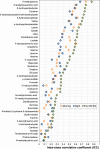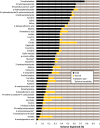Assessment of metabolic phenotypic variability in children's urine using 1H NMR spectroscopy
- PMID: 28422130
- PMCID: PMC5395814
- DOI: 10.1038/srep46082
Assessment of metabolic phenotypic variability in children's urine using 1H NMR spectroscopy
Abstract
The application of metabolic phenotyping in clinical and epidemiological studies is limited by a poor understanding of inter-individual, intra-individual and temporal variability in metabolic phenotypes. Using 1H NMR spectroscopy we characterised short-term variability in urinary metabolites measured from 20 children aged 8-9 years old. Daily spot morning, night-time and pooled (50:50 morning and night-time) urine samples across six days (18 samples per child) were analysed, and 44 metabolites quantified. Intraclass correlation coefficients (ICC) and mixed effect models were applied to assess the reproducibility and biological variance of metabolic phenotypes. Excellent analytical reproducibility and precision was demonstrated for the 1H NMR spectroscopic platform (median CV 7.2%). Pooled samples captured the best inter-individual variability with an ICC of 0.40 (median). Trimethylamine, N-acetyl neuraminic acid, 3-hydroxyisobutyrate, 3-hydroxybutyrate/3-aminoisobutyrate, tyrosine, valine and 3-hydroxyisovalerate exhibited the highest stability with over 50% of variance specific to the child. The pooled sample was shown to capture the most inter-individual variance in the metabolic phenotype, which is of importance for molecular epidemiology study design. A substantial proportion of the variation in the urinary metabolome of children is specific to the individual, underlining the potential of such data to inform clinical and exposome studies conducted early in life.
Conflict of interest statement
The authors declare no competing financial interests.
Figures




References
-
- Gluckman P. D. & Hanson M. A. Living with the Past: Evolution, Development, and Patterns of Disease. Science (80-.). 305 (2004). - PubMed
-
- Holmes E., Wilson I. D. & Nicholson J. K. Metabolic Phenotyping in Health and Disease. Cell 134, 714–717 (2008). - PubMed
-
- Mantovani A. & Fucic A. Puberty dysregulation and increased risk of disease in adult life: Possible modes of action. Reprod. Toxicol. 44, 15–22 (2014). - PubMed
Publication types
MeSH terms
Substances
LinkOut - more resources
Full Text Sources
Other Literature Sources
Medical

